When my friend Brad started growing dragon fruit some years back, his friend Simon told him not to bother with any variety except 8-S, which is also called Sugar Dragon. “I’ve tried all the other ones,” Simon told him. “Don’t bother. Just grow 8-S.”
“But I have to try them for myself,” Brad had replied to Simon. So he did. Brad ordered cuttings from all over the country, all over the world, and spent a handful of years growing out varieties of every sort. I watched Brad’s experiments, I photographed the new plants, I tasted the fruit when they came ripe.
“Simon was right,” Brad concluded in the end. “There are others with good fruit but the plants all have issues. I’m taking most of them out.”
As I go through this post about growing dragon fruit in Southern California, it will become clear why many seasoned dragon fruit growers (and eaters) in our region have such an appreciation for 8-S, Sugar Dragon.
I’ll share my personal experience growing dragon fruit, but more importantly I’ll share the deeper experiences of dragon-fruit growing friends so that you can shorten your learning curve while growing these tasty, night-blooming cactus vines.
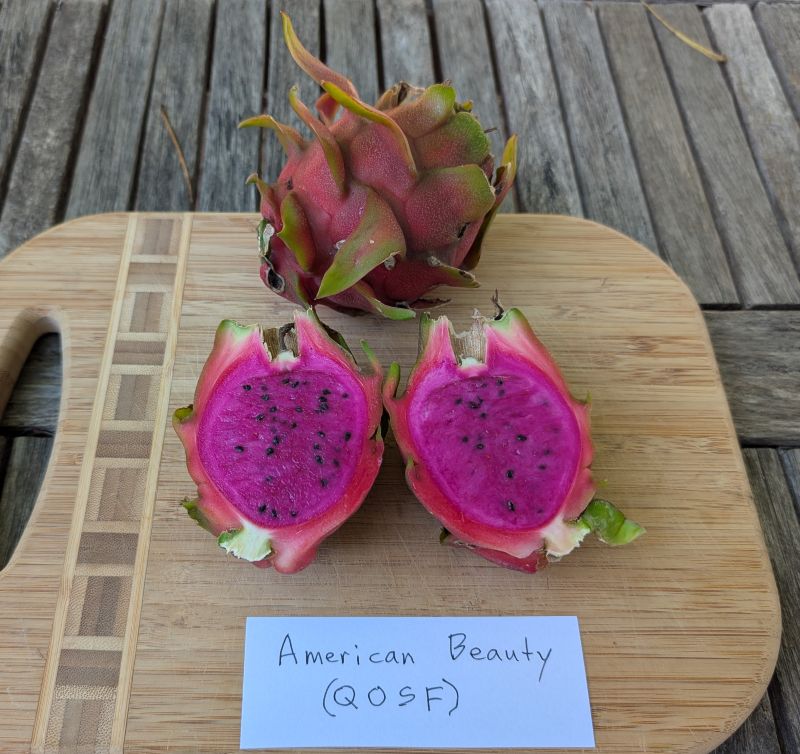
Flowering and pollination
One advantage of the 8-S variety is related to flowering and pollination. Some dragon fruit varieties are self-fertile so they can make fruit without needing the pollen of another variety of dragon fruit. 8-S is one such self-fertile variety.
However, other dragon fruit varieties need to be cross-pollinated. This is a challenge for two reasons. One, it means that you need to grow at least two dragon fruit varieties in your yard.
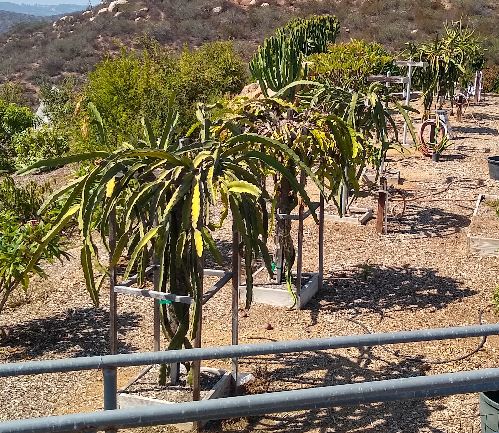
Two, it means that in order to ensure cross-pollination you must hand pollinate the flowers, and this has to be done at night, as that is when dragon fruit flowers open. It’s possible in the evening and early morning, but in general, dragon fruit flowers open at night.
How to hand pollinate dragon fruit flowers? See this video demonstration and discussion by Gray Martin, a dragon fruit farmer in San Diego County.
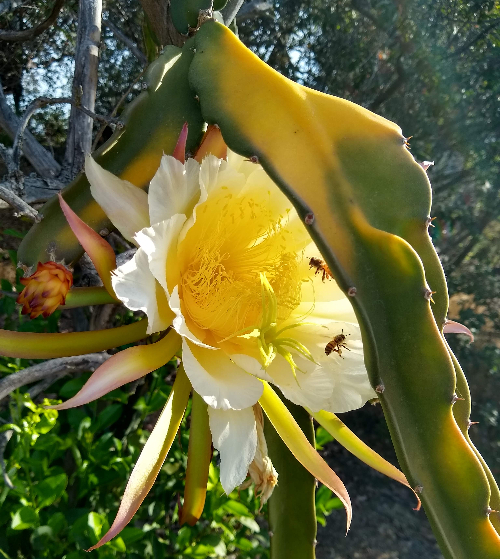
That said, bees, moths, and other pollinators will cross-pollinate for you if you have many dragon fruit plants of many varieties growing in proximity. I have seen such plantings, and they still get lots of fruit without any hand pollination — even from varieties that are said to be not self-fertile.
How to know if a particular dragon fruit variety is self-fertile? I would assume any variety is not self-fertile unless you are told otherwise from a source with firsthand experience. Search the dragon fruit thread at Tropical Fruit Forum to find growers sharing such experience.
The only variety that I can say with certainty is self-fertile is 8-S, and that’s because for many years it was the only variety I grew and my 8-S vines made fruit.
It is claimed by some that hand pollinating varieties that are self-fertile is still beneficial in that it results in larger fruit, but I’ve not seen any definitive evidence for this.
The emergence of flower buds on a dragon fruit vine is subtle considering how large and showy they become.
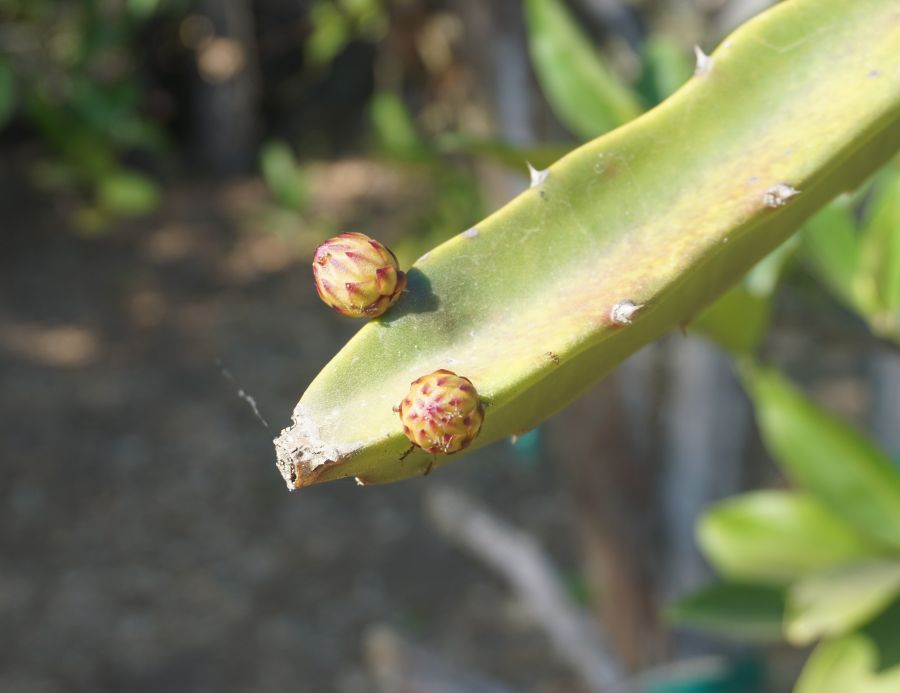
In this video I show the entire flowering process on a dragon fruit plant:
Supporting vines
Besides the complications of flowering and pollination with dragon fruit, the other challenge is how to support this plant that has spines and gets very heavy. In the wild, dragon fruit plants sprawl along the ground or climb up a tree or whatever else is nearby.
Around Southern California, I’ve seen dragon fruit plants climbing on rock walls and chain link fences and grapevine trellises.
And wood fences.
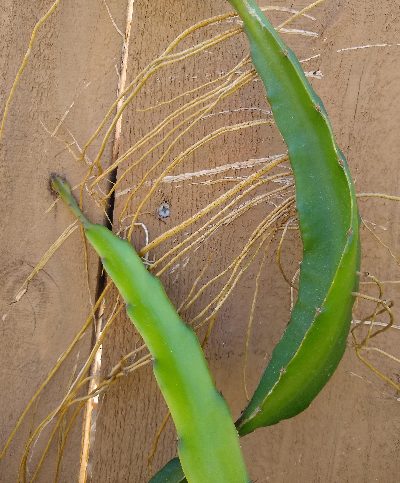
And palm trees.
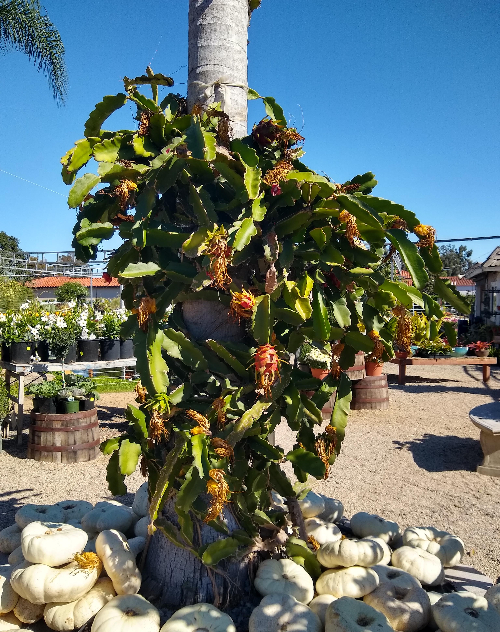
And elderberry bushes.
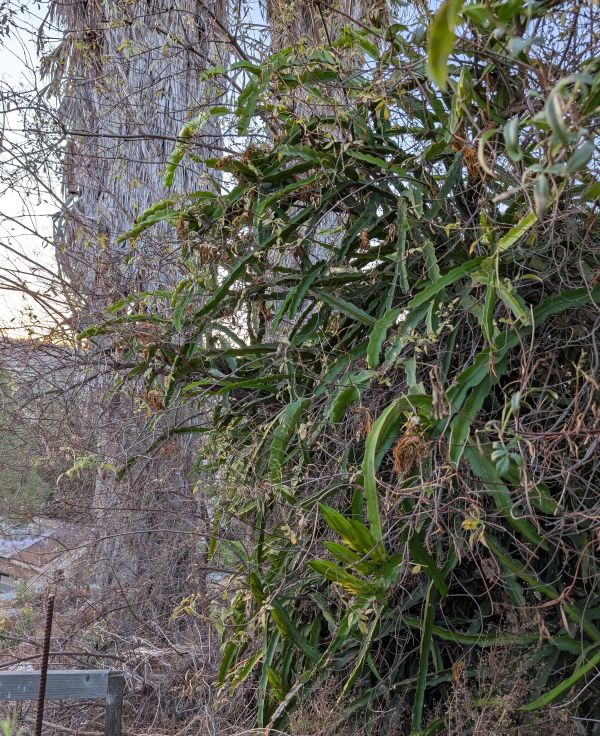
And wood rails and retaining walls.
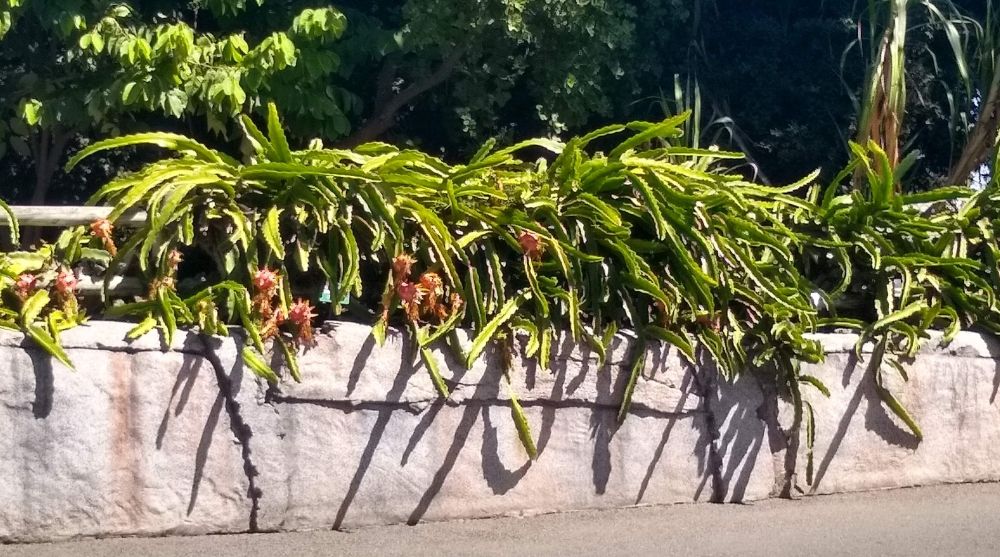
And everything all at once.
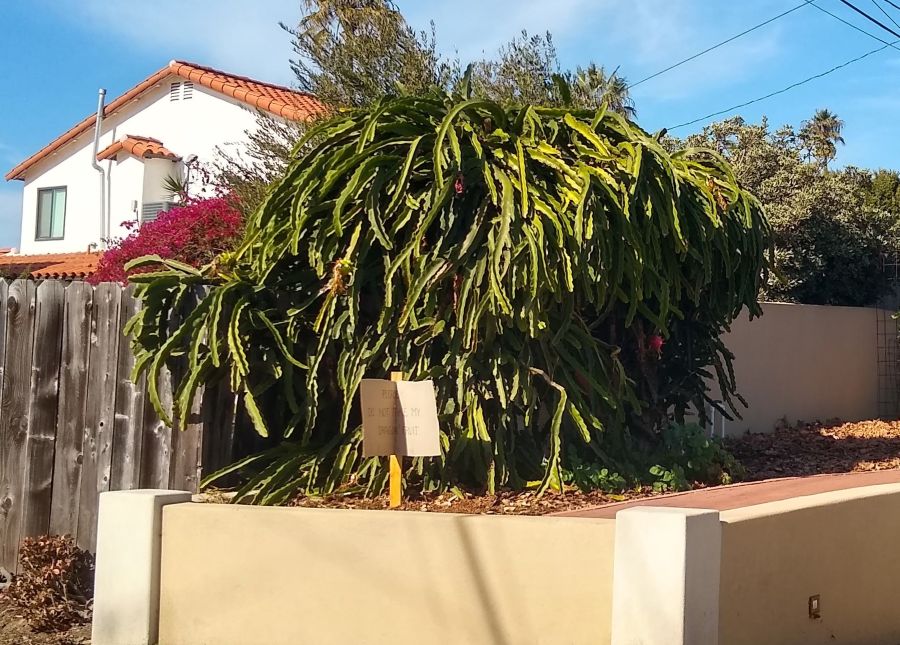
At my place, I let some dragon fruit vines climb up old citrus trees, and I let others climb up abandoned metal fence posts.
But most people build supports specifically for their plants, and effective designs are innumerable. In common, most support structures have three characteristics: a central post for the vine to climb, cross supports at around five or six feet off the ground for the vines to cascade over, and finally, strength. The structure must be strong enough to hold up a mass of heavy mature plant material. The main mistake I’ve seen people make is not building the support strong enough (in conjunction with not pruning the plant enough).
Here are some examples of dragon fruit support structures that I’ve seen working well (you’ll see others elsewhere in the post):
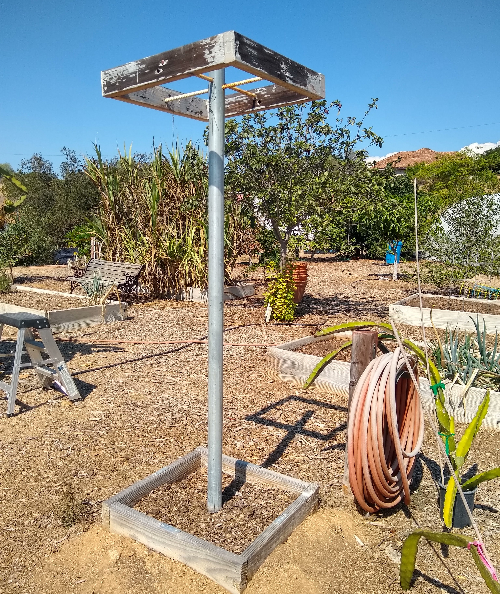
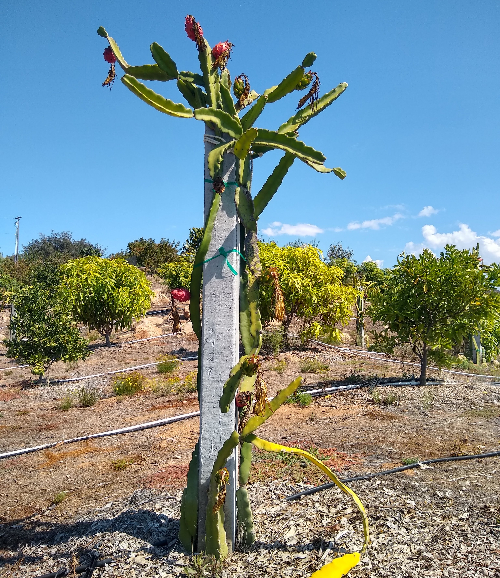
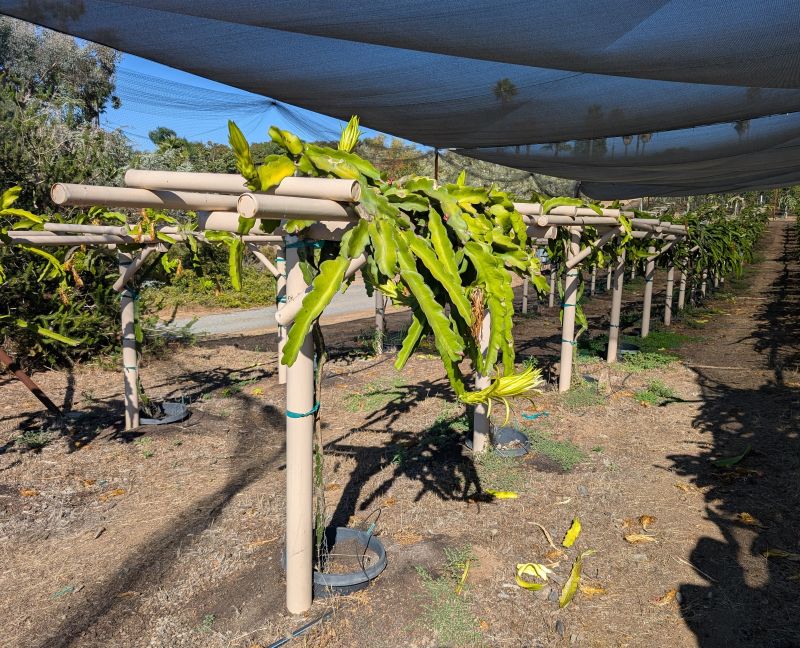
Planting and environment
I’ve seen dragon fruit plants growing well in sandy and loamy soils, but I haven’t seen them growing well in unamended clayey soil. Not that they can’t. That’s just what I’ve personally observed.
It’s common for people to plant dragon fruit in the ground still inside a large (15 gallon) plastic pot, with the bottom of the pot having many holes. This gives some protection from gophers.
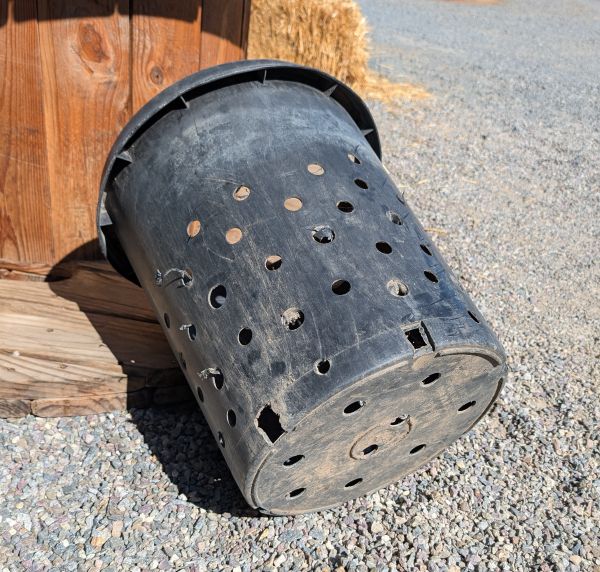
But lots of people plant straight into the ground too. I’ve put my dragon fruit plants straight into unamended sandy loam dirt. I control gophers by trapping.
I have had rabbits nibble on the base of my plants, and I know others deal with this too. I now protect the base of my dragon fruit plants with shade cloth or poultry wire. It only needs to be about a foot high.
You can grow dragon fruit plants in pots permanently. The ultimate size of the pot for a mature plant needs to be at least 25 gallons, from what I’ve seen. That’s about the size of a half wine barrel. Maybe you could get by with a smaller pot if you kept the plant pruned small.
Planting in full sun is generally best. If a dragon fruit plant is in much shade it won’t flower much. But there are places inland where the sun can be too intense. I live in such a place (Ramona, San Diego County). I still grow my dragon fruit in nearly full sun but incur some sunburn on certain vines.
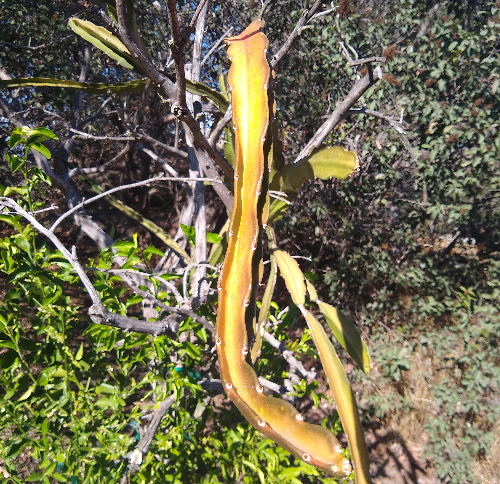
A dragon fruit farm down the road from me has erected shade cloth over their plants, and the plants like it.
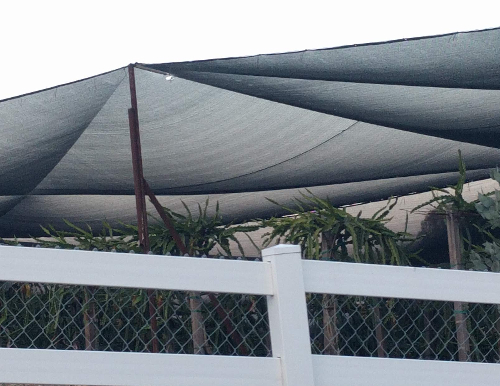
Dragon fruit plants don’t appreciate frost. They’ll take a little frost, especially certain varieties, but they’d prefer to never have temps in the 30’s or below. My plants have gone through nights in the upper 20’s without significant damage though; they just yellowed temporarily.
Varieties that are said to take both heat and cold well are 8-S, Valdivia Roja, Physical Graffiti (1-S), Haley’s Comet, and Lisa, according to Ramiro Lobo of the University of California. (See minute 40 in this video.) In contrast, the yellow variety called Colombiana cannot handle high heat nor low temperatures.
Growing from cuttings
A piece of a dragon fruit vine that is around a foot or two long can be rooted and grown into a new plant. You can successfully root dragon fruit cuttings in a variety of mixes. Here is a video where Ramiro Lobo shows how he does it.
Here is a cutting that I began to root on January 28, shown on April 27 ready to be planted:
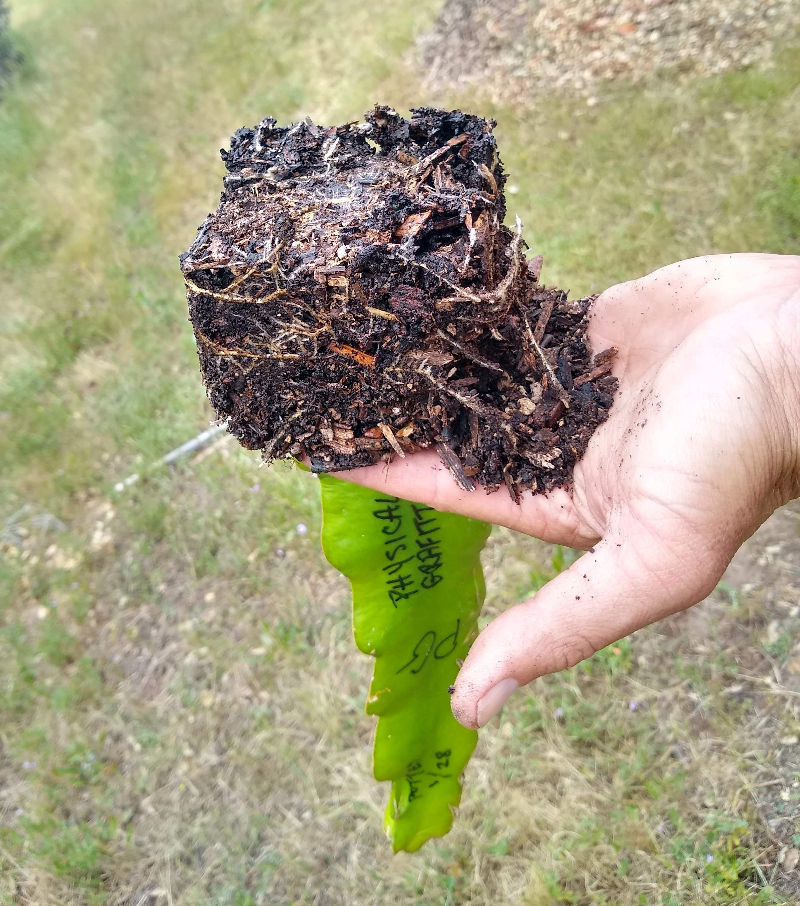
Where to buy plants and cuttings
The fall is a good time to buy cuttings since many growers are starting to prune their plants.
For places to buy cuttings, check out local farms: Wallace Ranch in Bonsall and Dragon Delights Farm in Ramona, both in San Diego County. Also see the Tropical Fruit Forum, where members sell cuttings.
Nurseries and even home improvement stores often sell potted dragon fruit plants, but the availability of varieties is more limited and sometimes the plants are not labelled specifically.
Training and pruning
Unless you are growing a dragon fruit vine in an unconventional way, you’ll want to train it so that it has a single leader coming out of the ground, only allowing it to branch once it gets near the top of its support. It will try to form side branches down low. Cut those off. If you don’t, then you’ll end up with a bush of vines going every which way but not vigorously up.
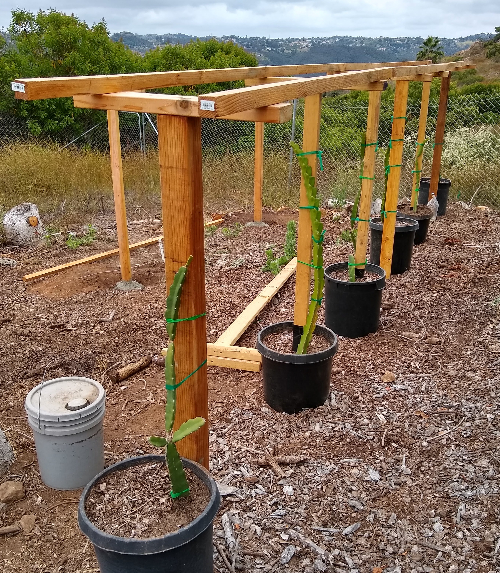
You prune and train the vine to a single leader going up the support and then allow it to form side branches that weep over the top of the support, forming an umbrella shape. Most of the flowers and fruit will form there at the umbrella top.
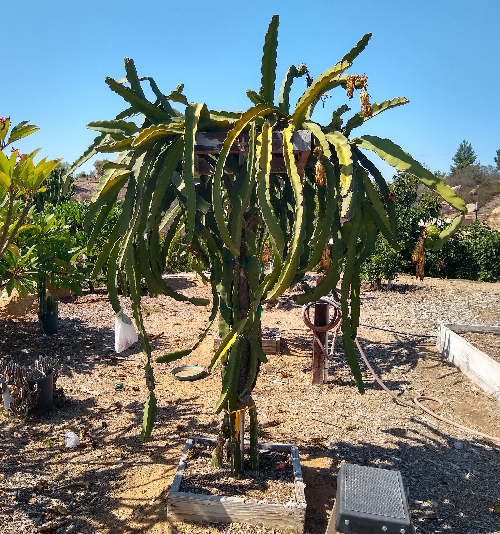
After a few years, the tangle of vines at the top will get so thick that some need to be removed each year. If you don’t, it might get so heavy that the structure topples.
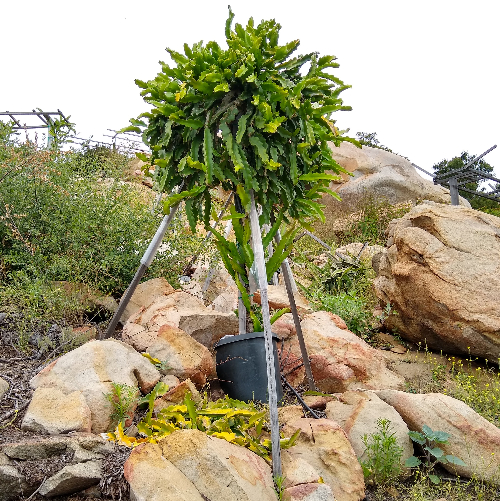
I once saw a large planting on the campus of Cal Poly Pomona that went unpruned for years, and the support structure fell down but the dragon fruit vines kept growing. It looked like a thicket of blackberries you’d see up in Oregon, except the canes were thick, spiny, heavy cactus. I felt sorry for whoever had to clean up that mess.
If you don’t prune, you’ll also lose some fruit since they won’t be able to form properly in the crowded center of the mass. Prune enough such that you can see a bit of negative space even through the center of the top of the plant. And don’t only cut off the ends of vines, but rather cut out entire vines from deep in the center of the plant; the ends of the vines are where many flowers are produced, and cutting off the ends only makes the vines regrow from there so they’ll soon be draping down to the ground.
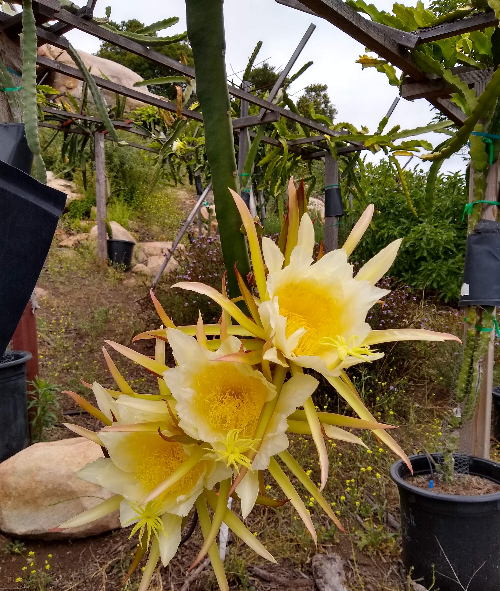
This video from Ramiro Lobo gives more detail on pruning.
Watering
Because dragon fruit vines are filled with a reservoir of water – they are cactus – they can survive on very little water. I have seen abandoned dragon fruit plantings in Southern California surviving without irrigation. I also neglected a couple of my own plants and watered them only a couple times each summer for two years straight, and yet they continued to grow but did not fruit.
If you want maximum growth and fruit, you must shower them with irrigation in Southern California summers.
How much to water? That depends on many factors, including the size of the plants and how much sun they are receiving, but dragon fruit need less water than most garden plants. How much less hasn’t been worked out for certain, as far as I know. I give my plants about as much as a mature tomato plant, about seven gallons per week in summer. Would my plants do better with more? Could I get away with less? I’m not sure.
How often to water? That also depends on whether the plants are in the ground or in containers, what kind of soil they’re in, etc. I water my dragon fruit using drip irrigation, and I water them 3-4 times per week in the summer, less often in other seasons. Friends who water by hand or with sprinklers irrigate about twice a week in summer. And I’ve heard other experienced growers only watering once per week in summer while still getting good results.
Fertilizing
As with water, dragon fruit plants will get by without much fertility in the soil, but they respond with more growth and fruit when provided with plenty of nutrition. I use compost that contains some chicken manure on my plants. Others do well using a fertilizer marketed for citrus and avocado trees.
Harvesting
Once a dragon fruit flower has been pollinated, it will dry and form a fruit at its base. The dried flower usually remains attached to the developing fruit.
As the fruit matures it changes color. Most varieties of dragon fruit begin with green skin, and some redden as they mature while others turn yellow or just remain green. You have to get to know your variety.
Farmers pick their fruit earlier than home growers. They need the fruit to be firm in order to handle transportation. The downside of this is that such early picked fruit lacks full flavor. Growing your own dragon fruit allows you to leave the fruit on the vine until it reaches exactly the height of sweetness and flavor that you prefer. That said, if you harvest too late you’ll find the texture of the fruit has become mushy.
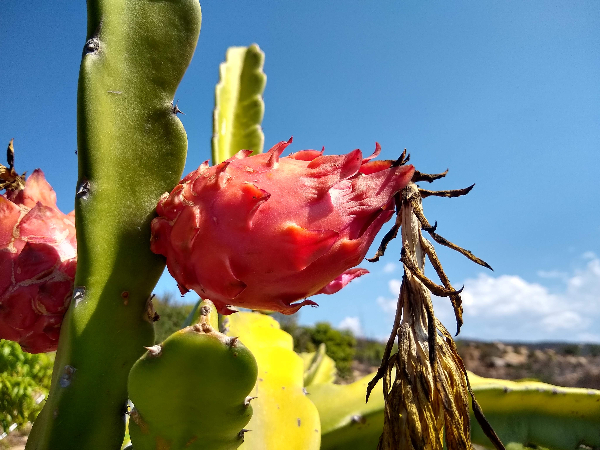
Birds are attracted to red ripening dragon fruit. You can prevent their damage with mesh bags.
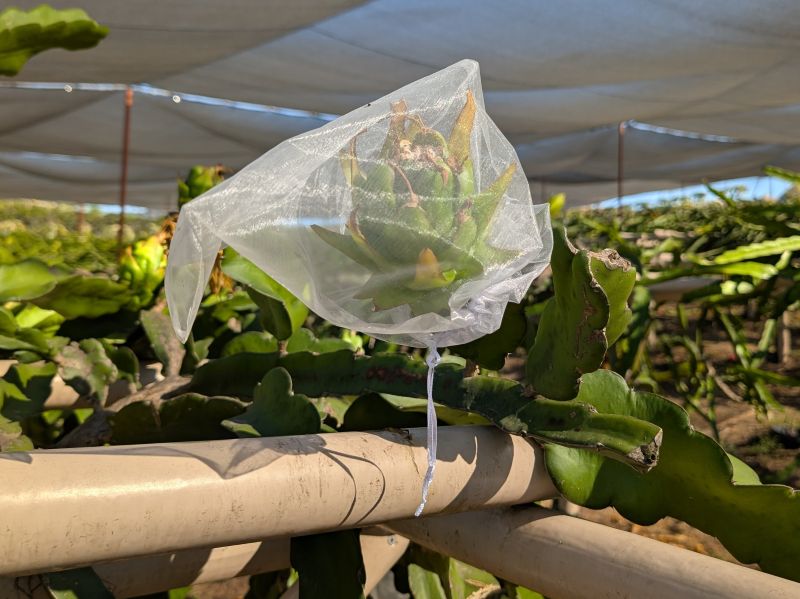
Varieties and names and history
The 8-S variety was created by Paul Thomson. Thomson was one of the co-founders of the California Rare Fruit Growers organization, he lived in San Diego County, did seminal work growing and breeding many fruits that were once rare in the area such as mango and cherimoya, and unfortunately passed away in 2008. One of the last fruits that he set his mind to developing was dragon fruit, which he called “pitahaya.” Thomson even published a small book in the late 1990’s called “Pitahaya – A Promising New Fruit Crop for Southern California.”
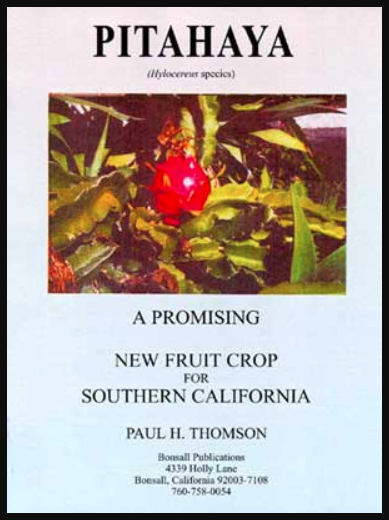
Some others call dragon fruit “pitaya.” For all practical purposes, pitahaya, pitaya, and dragon fruit are the same thing.
Thomson made a series of crosses between dragon fruit cultivars and came up with outstanding new varieties. He referred to these new varieties as 1-S, 2-S, 3-S and so on, up until 9-S. The “S” stands for seedling.
Thomson’s “S” varieties got passed around, and others eventually gave them more memorable names. For example, 8-S picked up the name Sugar Dragon from a San Diego County grower, and 1-S started to be called Physical Graffiti by a nursery in Florida.
This passing around of cuttings and renaming of varieties has led to some confusion. Many varieties go by multiple names, and there is even a bit of controversy over whether certain varieties sold under different names are actually the same. (For example, is Bien Hoa Red the same as American Beauty? See minute 41 in this video.)
Which varieties are the best to grow in Southern California?
As previously mentioned, I’m not alone in finding 8-S the best overall in terms of fruit taste and ease of growing for Southern California. All seasoned dragon fruit growers that I know recommend 8-S for anyone who will grow only a single variety. The only downside of 8-S is that the fruit isn’t as big as some other varieties.
After 8-S, which varieties should you add? Many growers’ number two is American Beauty because it is also self-fertile, highly productive, has beautiful color in its flesh, and tastes very good.
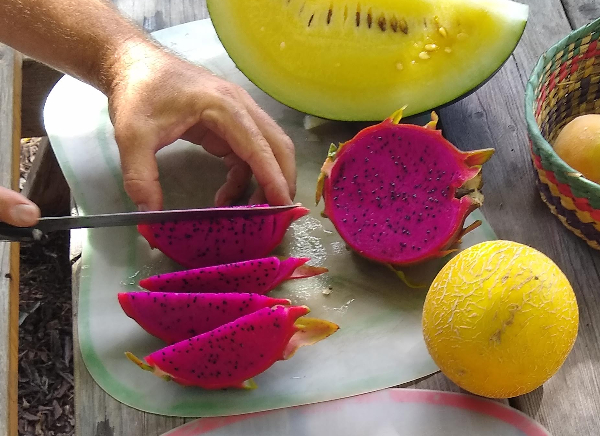

Beyond 8-S and then American Beauty, there are no clear picks, but I’ll list a few more that are good eating and whose plants perform well at my place or at other Southern California locations I’ve observed. Physical Graffiti (Paul Thomson’s 1-S) is highly productive, rates near the top in taste for most people, and takes heat and cold well. It is apparently not self-fertile, however.
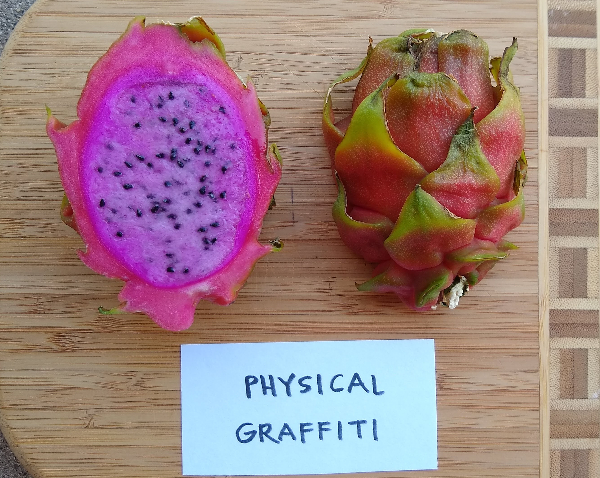
Delight (Paul Thomson’s 3-S) is said to be self-fertile and has proven to be productive, and it has faintly pink flesh with nice flavor. Paul Thomson actually rated its flavor superb compared to his other seedlings.
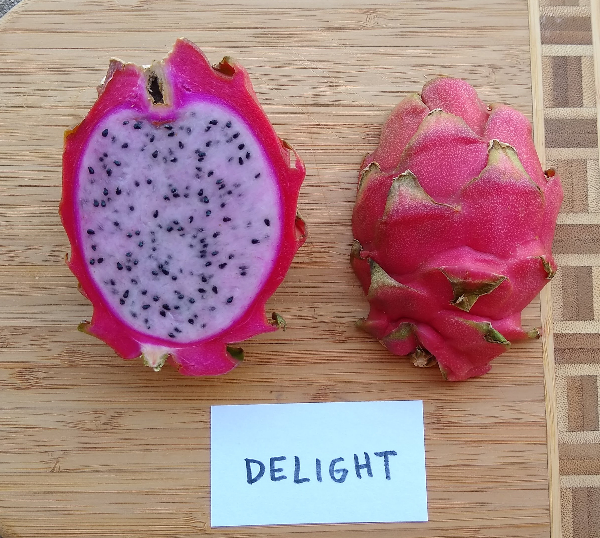
There are many other dragon fruit varieties that one can explore. Generally speaking though, white-fleshed varieties tend to taste sweet but bland (to me).
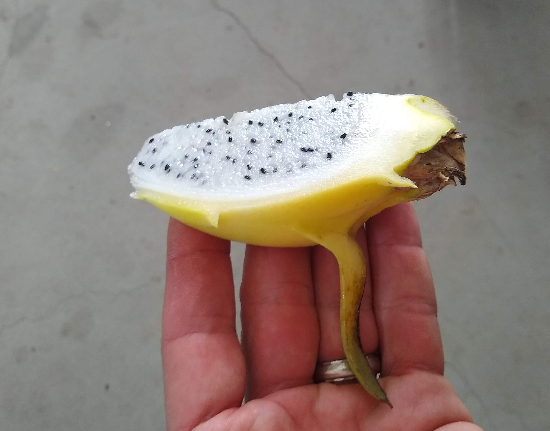
While other varieties taste surprising.
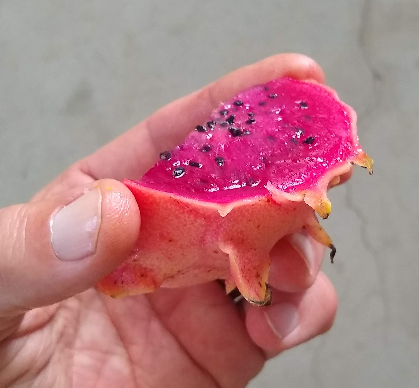
And some varieties are not well suited to the climate of Southern California; they need it warmer year-round. They can also be very spiny — even the fruit.
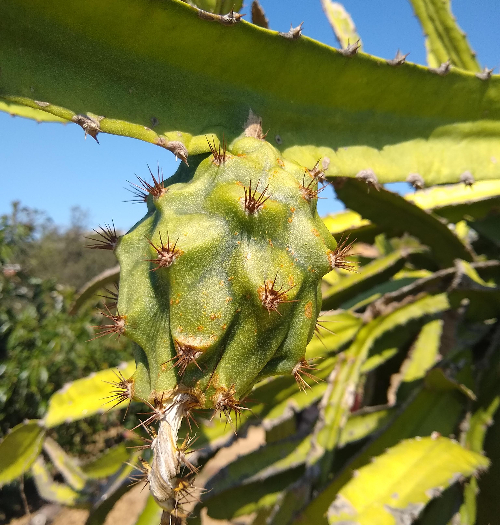
And there are varieties with marvelous magenta or pink flowers, but the plants don’t grow the best for most people and the flavor of the fruit isn’t the best to me.
Also there are new varieties being bred or selected by farmers right here in Southern California, such as Robles Red from Wallace Ranch in Bonsall and this beauty from Gray Martin of California Sweet Dragon:
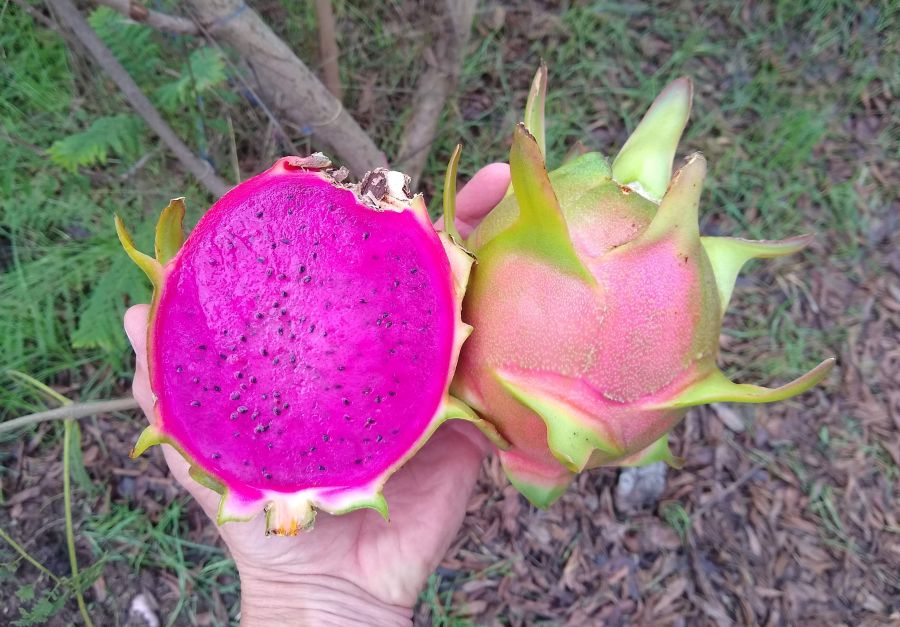
Where to buy fruit (to taste-test varieties)
If you’d like to taste dragon fruit varieties before deciding on which to grow, you’ll probably want to avoid grocery stores. The dragon fruit in grocery stores are not usually labelled by variety, not to mention that they are usually poor tasting too. In fact, a few years ago I gave my brother-in-law an 8-S fruit, which he loved. He started telling his friends that dragon fruit are delicious. Then he bought one in the grocery store. He paid about $10 for it, yet it had white flesh that was mealy and bland.
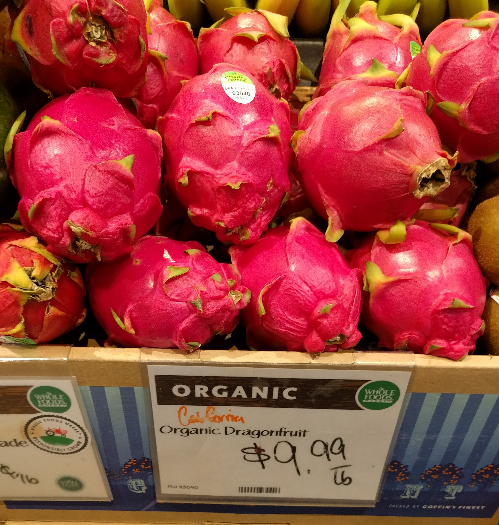
The best varieties and highest quality fruit are to be found at farmers markets and directly from farmers or hobby growers. There are now dragon fruit farmers throughout Southern California so you should be able to find some at most farmers markets, and the farmers should be able to identify varieties for you.
Also, you can buy direct from some farms. All of the ones that I can personally vouch for are in San Diego County. One such farm is near me in Ramona: Dragon Delights. Another is Rancho Los Serranos in Valley Center. And there is Wallace Ranch in Bonsall.
And you can buy direct from home growers through the Tropical Fruit Forum. The season for dragon fruit in Southern California runs from about June into November although peak production is usually August and September.
A few exceptions: Some local farms do supply smaller, specialty grocers. For example, Gray and McIan Martin’s fruit from their California Sweet Dragon farms are found at Gelson’s and Jimbo’s. Often, the provenance of the fruit can be found on the sticker; look for that.
A final note: Try chilling your dragon fruit in the fridge before eating it. To me, dragon fruit tastes much better when chilled.
And to this day, to me, nothing tastes better than a chilled 8-S.
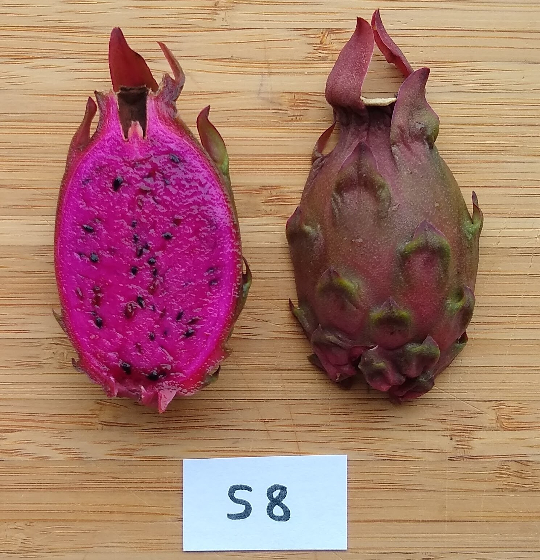
Or a handful of chilled 8-S.
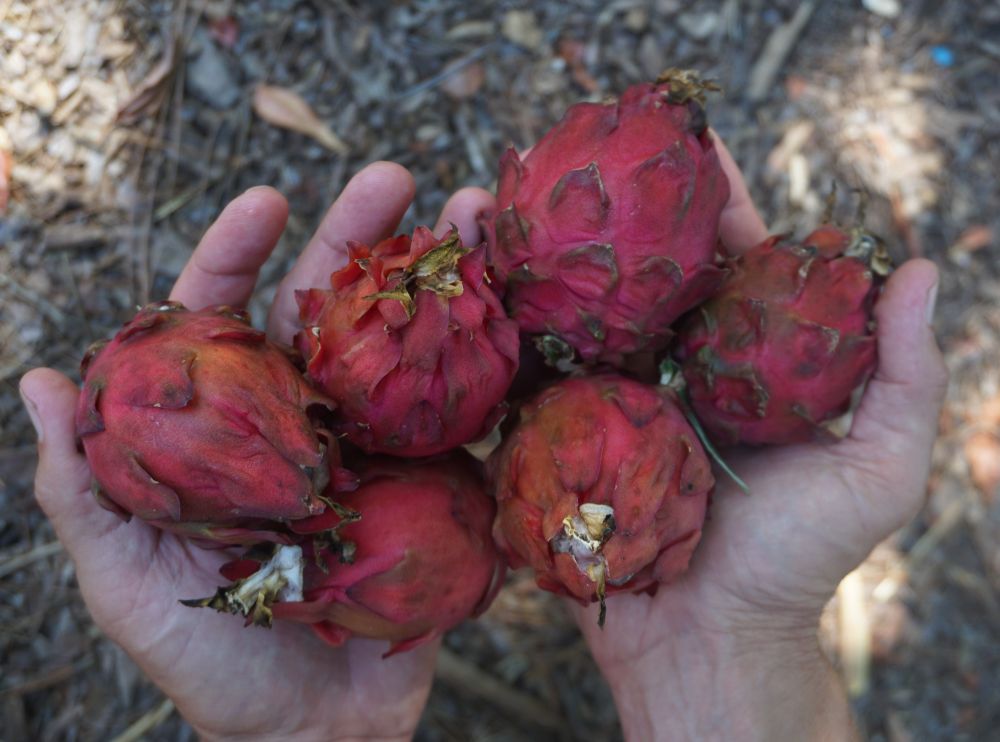
All of my Yard Posts are listed here.
No ads appear on this website because I get support directly from readers like you. It is the only income, and it keeps the Yard Posts coming. Thanks! (Learn more here.)

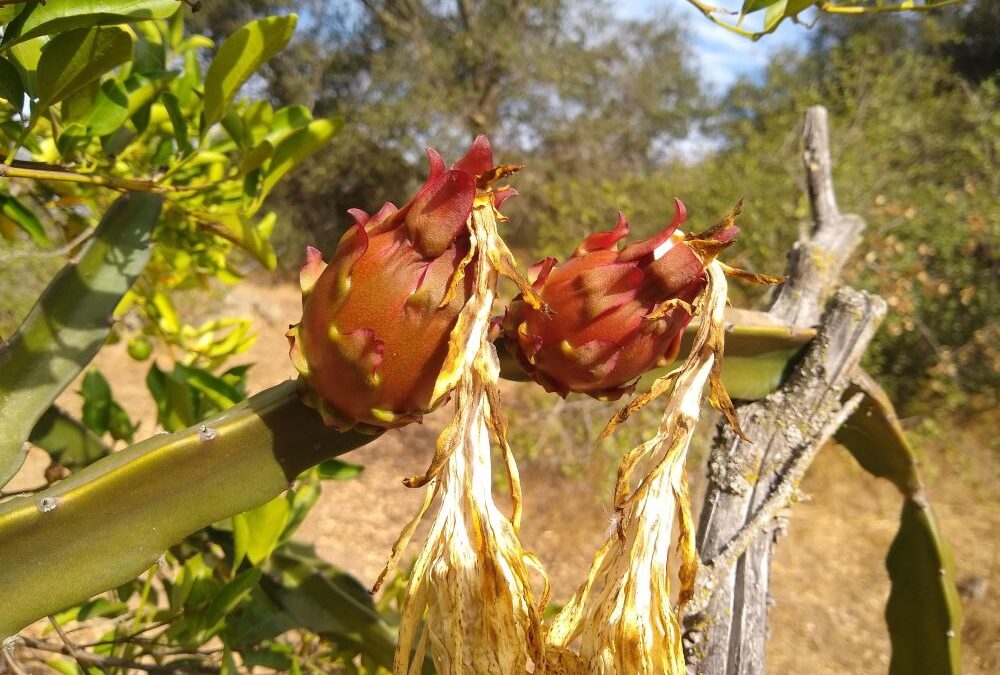

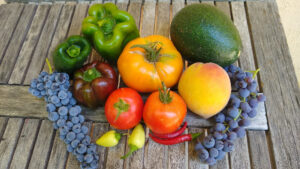
Greg – I really look forward to your posts even though I have a small, urban yard. I have a problem and would like your advice. I’ve had hardy agapantha in my yard for years but this year they are dying! Simultaneously, I’m finding empty snail-type shells fairly frequently along the edges of agapantha plants. I have never found a shell with the snail inside and the shells are not brown; they are white! Do you know what I can do to rescue my plants? Thanks, Sally
Greg, interesting dragon fruit post. We are in Ramona as well, 78 near Weekend Villa. We have dragon fruit plants growing along a split rail fence, but thinking of taking that out and build post/canopy structure. Are you able to do a visit and provide recommendations?
Excellent article, as always. Thank you. The only dragon fruit I’ve ever thought was decent are the yellow ones that Trader Joe’s has had the last couple of summers. I tried to grow some from seeds, which sprouted but then refused to grow past an inch tall and after about 4 or 5 months they shriveled and turned yellow. so I’m excited to hear that the pink and white one’s actually do have a flavor and sweetness if grown and harvested well. I’ll be leaving this king for them at my farmers market, even though I have not seen them before. I would love to try the S-8 one question I still have is, do they typically grow well from seed?
Hi J,
You can grow dragon fruit from seed. It does, however, take longer to get fruit from compared to cuttings. And it’s more difficult, as you experienced. That’s what I hear anyway; I’ve never grown dragon fruit from seed. Dragon fruit don’t grow true to type from seed either so the vine that grows will make fruit somewhat different from the fruit from which the seed was taken.
I’ve been growing about 18 dragon fruit varieties over a range that extends from 10 to 22 years. I disagree with the majority; 8-S is the sweetest variety I grow, but I don’t consider it the best. Its fruits are also appreciably smaller than fruits of most other varieties. Other names for 8-S are Sugar Dragon and Voodoo Child. Whether different varieties are self-fertile or not seems to depend on levels of humidity and other unknown factors. This season all my varieties fruited without cross-pollination, but most years most of them have needed cross-pollination. Cross-pollinated blooms usually make larger fruits. Delight, or 3-S, is my most productive variety, one plant producing well over 100 fruits this year. Which has best flavor varies from year to year.
Thanks for adding this, Don.
It seems there is still so much to be learned about dragon fruit pollination. I know that I don’t know much about it, but even growers like you who have observed many varieties for many years still aren’t sure of all the factors involved. As this gets figured out, it will make growing dragon fruit easier and more productive in backyards, but it will especially save the commercial growers in Southern California time spent hand pollinating.
Thanks for a very informative article. I don’t think I am going to stop hand pollinating the over 400 plants here, it’s a good chance to see how they are doing and note the work I am behind on, pruning, weeding, replacing.
People will argue about which is the “best” variety forever, but that, like trellis structures and the best avocado variety, is really up to personal taste and the demands/resources of the site. I notice that most of the time we don’t water ours for about ten days, even during the highest heat, but we also have less problems with rot than others so maybe that is one reason. I don’t think “Voodoo child and “S-8″ or 8-S” are the same, I have both and they are different. I think there are a lot of related seed sisters and “Pink Panther”, “Voodoo child”, and “Neon”, are in that category, as well as “Houghton” one of the parents of “S-8”. There is a lot of confusion about varieties, some of it is purposeful, as people rename things for sales, some of it is accidental. I’m growing lots from seed now and one challenge is keeping the seedlings safe when they are small. Lots of things like to eat them, from insects to lizards to mice and birds! Jwaldemar If you are not breeding, get a cutting!
I would say you are better off getting a fruit from a Farmers Market, but know what you are getting, I saw a Nursery booth selling white flesh fruit the other day, and if you enjoy that fruit, it is probably a good choice, if you are after the pink or red fleshed, talk to the person selling and see if you can taste test them. We sometimes allow people to come out to our farm who are interested in fruit, sometimes we have tours, hope everyone has a good season next year, ours is winding down but we will have fruit for a few months more, I saw some S-8 this morning I need to pick.
Hi Greg;
I am the head Farmer at Wallace Ranch in Bonsall, CA. Your article is a great intro to growing dragon fruit, thank you for including us. A Growing Passion KPBS did a segment during the pandemic on Pitahaya/Dragonfruit that supports your article and helps fill in some gaps. https://www.kpbs.org/news/arts-culture/2021/04/14/growing-passion-pitajaya-dragon-fruit We are always open for a walk-through and educational tour if ever needed. We have been growing Dragon Fruit since 2–8 and started larger-scale commercial Organic production in 2013. We enjoy being a part of the San Diego community and the larger Dragon Fruit community. Feel free to reach out. On a side note, Your articles on avocados helped me significantly- especially on mulching; greatly appreciated your insight. Mahalos, Neva
Thank you so much for this, Neva. I missed the field day tour of your place this summer so I’m eager to visit. Other growers speak highly of what you’re doing at Wallace Ranch.
Thank you for the very interesting article. Somebody gave me a dragon fruit plant but I know nothing about them. Just to clarify, the plant in the video is in a small pot and growing up a tree?
Hi Vickie,
The plant in the video is in the ground, not in a pot, but it is growing up a tree (an old tangerine tree).
another great post Greg; I have this dragon fruit in pots, growing out of control. I need to know the species. Is there a agricultural lab where I can take samples? I’ll send you a pic.
thanks,
tommcdougall
Hi Tom,
I don’t know of a lab that could do that for you, but there are many growers of dragon fruit who can identify varieties just by the look of the vine and its thorns. A piece of cut fruit only helps. Post some photos at Tropical Fruit Forum and I’ll bet you’ll at least get a good idea of which kind you have.
thanks, tom
My daughter gave me a dragon fruit plant. And I’ve been getting info on YouTube. It now has red flowers. What do I have?
I bought a pink fruit and didn’t find it tasty. But I bought a yellow one later and it was sweet and tasty. My flower will bloom tonight. I can’t wait to find out what color the fruit will be. How long will the plant last and should I keep planting new ones.
Hi! I live in Sunnyvale and bought a dragonfruit from local HomeDepot this April. Got my first flower tonight(Oct 15 2024) and I did hand pollination soon afterwards. I actually didn’t pay attention to the variety when I bought it–looks like American Beauty with big white flower. I read somewhere online that it will take 40-45 days for a fruit to mature, if there is any for my plant;). But is it too cold for it to even survive? What can I do? I have a blanket if that helps:)
Thank you.
Hi Jo,
I also have a dragon fruit plant that just opened a group of flowers. I don’t know your yard’s temperatures, but I know that we can still get dragon fruit to develop through the fall and early winter down here. I ate some that were harvested in early January last year. They don’t tend to color up on the skin as nicely at that time of year, but the flesh still looks and tastes great.